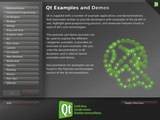How to Learn Qt
|
 | Getting an Overview If you run the Examples and Demos Launcher, you'll see many of Qt's widgets in action. The Qt Widget Gallery also provides overviews of selected Qt widgets in each of the styles used on various supported platforms. |
Qt comes with extensive documentation, with hypertext cross-references throughout, so you can easily click your way to whatever interests you. The part of the documentation that you'll probably use the most is the API Reference. Each link provides a different way of navigating the API Reference; try them all to see which work best for you. You might also like to try Qt Assistant: this tool is supplied with Qt and provides access to the entire Qt API, and it provides a full text search facility.
There are also a growing number of books about Qt programming; see Books about Qt Programming for a complete list of Qt books, including translations to various languages.
Another valuable source of example code and explanations of Qt features is the archive of articles from Qt Quarterly, a quarterly newsletter for users of Qt.
For documentation on specific Qt modules and other guides, refer to All Overviews and HOWTOs.
Good luck, and have fun!
| Cette page est une traduction d'une page de la documentation de Qt, écrite par Nokia Corporation and/or its subsidiary(-ies). Les éventuels problèmes résultant d'une mauvaise traduction ne sont pas imputables à Nokia. | Qt qtextended4.4 | |
| Copyright © 2012 Developpez LLC. Tous droits réservés Developpez LLC. Aucune reproduction, même partielle, ne peut être faite de ce site et de l'ensemble de son contenu : textes, documents et images sans l'autorisation expresse de Developpez LLC. Sinon, vous encourez selon la loi jusqu'à 3 ans de prison et jusqu'à 300 000 E de dommages et intérêts. Cette page est déposée à la SACD. | ||
| Vous avez déniché une erreur ? Un bug ? Une redirection cassée ? Ou tout autre problème, quel qu'il soit ? Ou bien vous désirez participer à ce projet de traduction ? N'hésitez pas à nous contacter ou par MP ! | ||
Copyright © 2000-2012 - www.developpez.com



















